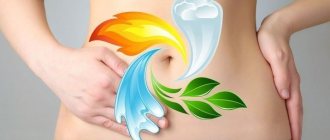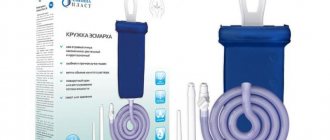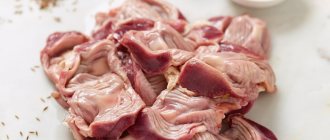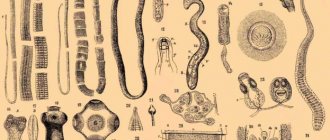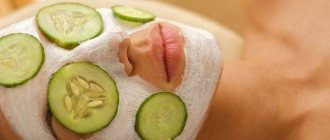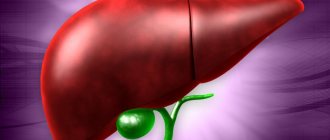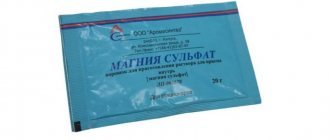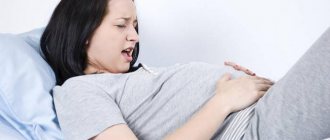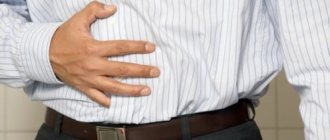People often think that visiting a proctologist is something scary and terrible. Many are simply embarrassed by their problem and prefer to endure until the last moment. However, if you do not contact a specialist in a timely manner, this can lead to disastrous consequences. The doctor will help identify proctological problems and prescribe proper treatment. There is no need to think that diseases associated with damage to the colon are shameful. No one is immune from this. Therefore, at the first signs of illness you need to go to the doctor. The only thing is that before visiting a proctologist you need to carefully prepare, otherwise the specialist will not be able to determine the severity of the disease and make the correct diagnosis.
How is the initial medical examination procedure carried out?
The examination takes place on a proctological chair (its design is similar to a gynecological one) or on a special couch; a knee-elbow position is used. At this stage, it is important to conduct a thorough diagnosis to rule out cancer.
Once the visual examination is completed, the doctor begins to palpate the anus.
The purpose of this procedure is to identify hemorrhoids, fissures, and determine anal tone.
The initial appointment for men also includes a prostate examination.
The procedure is carried out using special ointments with an anesthetic, wearing disposable medical gloves. Based on the results of the examination, the doctor makes a conclusion and prescribes appropriate treatment.
Basic rules of preparation
In order for the examination by a specialist to be as informative as possible, it should be approached thoroughly.
Proper preparation for the examination includes dietary restrictions (diet), cleansing of all parts of the intestines with an enema or laxatives.
Dietary restrictions
1-2 days before the proctological examination, avoid eating foods that cause gas formation. Vegetables that contain a lot of fiber, such as cabbage, should also be avoided.
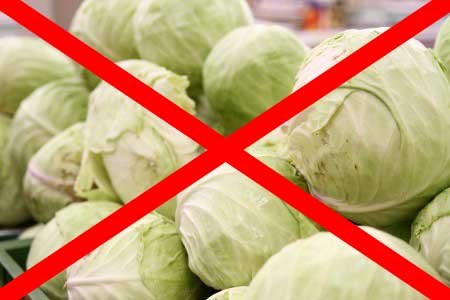
You should not eat yeast dough, carbonated drinks, or sweets. During this period, activated carbon is recommended - this can reduce gas formation.
Do I need to do an enema before the appointment?
Experts recommend using an Esmarch mug before examining the intestines as the simplest but most effective method of cleansing it.
The enema is done at night and in the morning 2-3 hours before the appointment, and you should not have dinner or breakfast. In the evening, 2 enemas are given 3-4 hours apart.
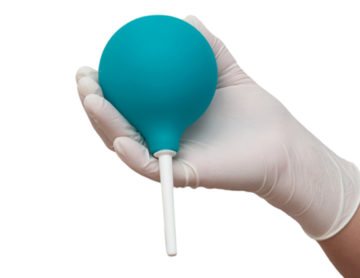
Colon cleansing is carried out with warm water (2 l). A rubber container is filled with liquid, the temperature of which is +36...+37 ᵒC, the end of the tube is lubricated with Vaseline, and it is inserted into the anus. After about 15-20 minutes, the urge to defecate begins.
Preparation process without using an enema
If there are problems in the anus (bleeding, advanced hemorrhoids), the enema should not be used. Laxatives are prescribed .
It is advisable to have a bowel movement early in the morning before visiting a doctor.
Microlax as an aid to preparation for examination
This drug is easy to use and quick-acting. The urge to defecate begins 20 minutes after administration. It is enough to carry out one morning procedure after consultation with a specialist.
According to indications, the Microlax enema can be prescribed in the evening. After the morning manipulation, eating and drinking are not recommended.
Preparation for examination - cleansing with enema
Before visiting a proctologist, it is important to properly prepare your body. An effective method of cleaning the intestines is an enema. The process is complex, but if you follow everything strictly according to the instructions, the result will be positive.
The procedure is carried out twice, the first enema should be done in the evening, the second in the morning, before the examination. The enema is performed on an empty stomach.
Preparing for an enema
For an enema, one and a half liters of liquid is used; you can use not only water, but also herbal infusions. There is no need to get carried away and perform several enemas at once; the minimum period between each procedure is four hours. An incorrectly performed enema can lead to an incorrect diagnosis, or prevent the doctor from seeing the problem.
Lymph nodes on the human body: where they are and what they are needed for
If possible, colon cleansing in this way should be carried out by several people. This will make the procedure easier and relieve the patient from discomfort and pain.
To perform the procedure, you will need a rubber heating pad, a silicone tip and a tube. Additionally, you need to prepare a ceramic mug, baby cream and liquid.
Boiled water is poured into the heating pad, and the tip is pre-lubricated with ointment. The patient needs to lie on his left side, bend both legs and carefully insert the tip into the anus. In this case, the heating pad should be one meter higher than the body. Next, the liquid is introduced very carefully and slowly. You need to wait a couple of minutes until all the water comes out of the heating pad. In a few seconds the urge to go to the toilet will begin, you don’t need to endure it.
Several such procedures are enough for the doctor to obtain an accurate picture of the disease.
How to prepare your bowels
Bowel cleansing is an important step in preparation for an examination. This procedure allows the doctor to make the diagnosis as accurately as possible.
Cleansing procedures can be done in various ways:
- cleansing with enema and water;
- cleansing with pharmaceutical enemas;
- use of laxatives.
How to prepare and how to properly cleanse the intestines is decided after a preliminary consultation with a proctologist. In some cases, with bleeding, polyps, or anal fissures, enemas are contraindicated.
The doctor selects the most comfortable and less traumatic method of cleaning the rectum.
Preparation for proctologist microlax
If you are planning an appointment with a proctologist, then it is advisable to prepare accordingly for the examination, that is, give a cleansing enema. Let us immediately make a reservation that if you have severe pain, it hurts to give yourself an enema or bleeding, then you do not need to give an enema before the initial medical examination. Do not injure the sore areas again. The doctor will carefully conduct the examination without this preparation. In general, before the initial examination, the patient gives two cleansing enemas of 1 liter each, approximately an hour before the appointment, with a break between them of approximately 45 minutes, the water temperature is about 37 degrees.
Also, you should not eat foods that cause flatulence the day before. If you have an appointment in the evening, but there is no way to prepare during the day, then a cleansing enema can be given after the morning bowel movement. An important condition for high-quality diagnosis is thorough cleansing of the intestine from contents.
An Esmarch mug is used to perform a cleansing enema. It can be bought at almost any pharmacy. An Esmarch mug is a glass, enamel or rubber container with a capacity of 1.5-2 liters. At the bottom of the mug there is a nipple onto which a thick-walled rubber tube is placed.
For a rubber reservoir, the tube is its direct continuation. The length of the tube is about 1.5 m, the diameter is 1 cm. The tube ends with a removable glass, plastic tip 8-10 cm long. The tip must be intact, with smooth edges. It is preferable to use plastic tips, since a glass tip with a chipped edge can seriously injure the intestine. After use, the tip is washed well with soap under running warm water and boiled.
Next to the tip on the tube there is a tap that regulates the flow of fluid into the intestines. If there is no tap, it can be replaced with a clothespin, a clip, etc. For enemas, use only water from proven sources that is safe to drink. For children, it is better to use only boiled water. The water temperature is about 37-38 degrees. Colder water significantly increases intestinal motility and causes unpleasant pain. Using water with a temperature of more than 40 degrees for an enema is dangerous to health.
Lie on the bed close to the edge on your left side with your legs bent and pulled towards your stomach. Place an oilcloth plastic film under the buttocks, lower the free edge of which into a bucket in case you cannot hold water. Pour 1-1.5 liters of water at room temperature into Esmarch's mug, lift it up to a height of 1-1.5 m and lower the tip down to release a small amount of water and along with it air from the tube.
Fill the tube, remove some liquid from the tube, then, without lowering the mug, close the tap on the rubber tube. Check if the tip is broken, lubricate it with Vaseline, soap, vegetable oil and, spreading the buttocks, insert the tip into the anus with light rotational movements.
The first 3-4 cm, insert the tip towards the navel, then another 5-8 cm - parallel to the tailbone. If there are obstacles and the tube rests against the intestinal wall or hard feces, remove it 1-2 cm and open the tap. Pressurized water will enter the large intestine. At these moments, you need to reduce the flow rate of liquid from the mug by closing the tap on the tube or squeezing it. Gentle circular stroking of the abdomen will help reduce discomfort. If the tip is clogged with feces, it should be removed, cleaned and reinserted.
If your rectum is filled with stool, try flushing it out with a stream of water. Esmarch's mug does not need to be completely emptied. Leaving a little water at the bottom to prevent air from entering the intestines, close the valve that regulates the flow of liquid and remove the tip.
Place a pre-prepared fabric pad, repeatedly folded strip of toilet paper, etc. on the perineum. Get on all fours in the bathroom in a knee-elbow position, leaning on one elbow, insert the tip into the rectum with your other hand.
The tip must be inserted slowly and carefully, especially with hemorrhoids. If not all the water has entered, and you already feel pain in the intestines, turn off the tap on the hose and breathe deeply.
When the water in the mug runs out, remove the tip and place a pre-prepared pad on the anus. It is advisable to hold the water for 10 minutes. To do this, lie on your back and breathe deeply. Soothe the pain and feeling of fullness in the abdomen with stroking.
If possible, walk around with the water injected or lie on your stomach. When administering a cleansing enema, you need to ensure that no more than 1.5-2 liters of liquid are administered at a time. If it is necessary to give two enemas in a row, you should maintain an interval of 45 minutes to 1 hour between them, making sure that the rinsing water from the first enema has completely drained. Microlax is a ready-made saline laxative solution in microenemas of 5 ml for single rectal administration, 4 pcs.
The laxative effect of this drug occurs minutes after administration. To prepare the intestine for examination, it is enough to use 2 microenemas. As a rule, emptying occurs minutes after the rectal administration of the 1st microenema; after emptying, the 2nd microenema is administered.
If after the introduction of the 2nd microenema there is no bowel movement, then you managed to prepare for the first one. Microlax acts gently, without irritating the intestines and without causing systemic side effects. Considering the safety of Microlax, it is recommended for adults and children, as well as for pregnant and lactating women.
To facilitate the administration process, you need to lightly press on the tube so that a drop of the drug lubricates the tip of the enema; Your name is required. Your phone number is required. Specialized clinic of coloproctology and gastroenterology. At the address: Moscow, st. Natasha Kovshova, house Skip to content. Now let's talk about how to give an enema correctly. Cleansing enema An important condition for conducting high-quality diagnostics is thorough cleansing of the intestine from the contents. So, let's look at ways to give an enema.
Rules for using Microlax: 1. Break off the seal on the tip of the tube; 2. To facilitate the administration process, you need to lightly press the tube so that a drop of the drug lubricates the tip of the enema; 3. Insert the tip of the microenema into the rectum; 4. Squeezing the tube, squeeze out its entire contents; 5. Remove the tip while continuing to lightly squeeze the tube.
Your name is required. Your phone number is required. The reason for the increase in hemorrhoids Read more.
Is colon cleansing always done?
This procedure is mandatory for almost all patients. But with rare exceptions, manipulation is not carried out in emergency cases.
In what cases is bowel cleansing not done at home:
- with severe lesions of the colon, anus,
- if there is a risk of bleeding after the cleansing procedure;
- oncological neoplasms.
In these cases, enema cleansing can be replaced by taking laxatives after consultation with your doctor.
Effect of laxatives
If it doesn’t work out, or you are afraid to perform an enema yourself, then you can cleanse the intestines with laxatives. The method is quite effective, but there is a big drawback - each medication has many side effects and contraindications. Even if all the ingredients are natural, this does not mean that there will be no negative reactions. It is advisable to consult a doctor before taking a laxative, who will select the necessary, effective remedy.
Laxatives help with chronic constipation or, conversely, with diarrhea.
Proctologists recommend using the following medications before the examination:
- Bisacodyl
- Lavacol
- Laxatin
- Microlax
- Fortrans
- Dulcolax
- Laxbene
- Pyralax
The most popular of these drugs is Microlax. It is available in very convenient packaging, in special microenemas. One syringe leads to complete cleansing of the intestines.
After taking the drug, you should not leave the house for the first few hours; it is during this period of time that the substance will begin to act on the intestines. Before examination by a proctologist, two such microenemas are performed. This drug was invented for such cases.
Medicines
Fortrans is also effective, but it should not be used if a person has:
- intestinal obstruction
- ulcerative colitis
- the presence of severe pain for no apparent reason
How to distinguish heart pain from osteochondrosis, what are the main signs of diseases, their diagnosis
Benefits of all laxatives:
- No outside help needed.
- There is no need to perform a specific and painful procedure.
- There is no need to diet.
Before using any such product, it is important to carefully read the instructions and study all contraindications. You can also take sedatives before visiting the clinic to help you stay calm and positive.
Preparation for examination of patients suffering from hemorrhoids
A week before visiting the clinic, they switch to dietary nutrition and liquid food. Avoid legumes, cabbage, grapes, yeast dough, and carbonated water.
It is recommended to consume fermented milk products. Enema is contraindicated for patients with hemorrhoids . It is possible, on the recommendation of a doctor, to cleanse the intestines for hemorrhoids using Fortrans.
A week before the examination, you should consult a coloproctologist. It is possible that medications will be prescribed to relieve inflammation.
Microlax before colonoscopy - rules for preparing for the study
During the procedure, the doctor can remove pathological tumors, stop bleeding, solve the problem of adhesions, and perform a biopsy for further histological examination.
The reliability of the study results is largely influenced by the patient’s preparedness and the degree of intestinal cleanliness. To cleanse the rectum of feces, they resort to drug treatment. Microlax microenemas are considered one of these drugs.
The product is equipped with special tubes with tips for unhindered introduction into the rectal lumen and subsequent injection. One package contains 4 microenemas. 1 tube - 5 ml of medicinal liquid.
You can administer enemas yourself, which is convenient for preparing for a colonoscopy at home. After injection of the composition, the intestinal response occurs within 10-20 minutes, which depends on age, condition of the rectum and the amount of congestion.
The product causes defecation in 5–20 minutes, depending on the individual characteristics of the person due to the combined composition, which should be familiarized with before use.
Rules of application
The procedure is as follows:
- Before use, you should perform thorough hygiene of the perianal area and wash your hands. Then take the tube, remove the protective seal on the tip and squeeze out a little product to provide lubrication.
- The microenema pipette itself should be in a vertical position. After depressurizing the tube, you need to squat down and carefully insert the tip into the rectal lumen. The drug is injected with a sharp movement (one or more).
- After administering the product, it is necessary to squeeze the anal sphincter muscles as much as possible, insert a cotton swab and lie down for 10-15 minutes until the first urge to defecate.
A lying position is necessary for better distribution of the medicinal composition throughout the rectum. Ideally, the pelvis should be raised above the couch by placing a bolster.
If the colonoscopy is scheduled for the morning, then the first stage of cleansing is carried out the night before. At 19-20 hours, the first two enemas are administered with an interval of 30-60 minutes. The second stage begins in the morning of the day. You need to get up early and perform cleansing procedures with the remaining two tubes.
It is important that cleansing is carried out 3-4 hours before the procedure.
You cannot eat in the morning, and the last meal should be no later than 18.00 the previous evening. If you have a strong feeling of hunger, you can drink rich berry jelly or unsweetened compote. Read more about what to drink before a colonoscopy in this article.
In the morning they have breakfast with slimy porridge and drink green tea without sugar. 5 hours before the procedure, the intestines are intensively cleansed. You can use 4 enemas at once with an interval of 30 minutes, periodically observing bed rest.
It is important that the last bowel movement occurs several hours before the colonoscopy.
The drug Microlax has one significant drawback - limitation in use. Thus, the product is ideal for people without problems with bowel movements, against the background of stable, formed stools. Widely used in pediatric practice, especially before minimally invasive research methods and surgery.
If there is chronic constipation, suspicion of fecal stones, or a burdened clinical history in the intestinal tract, then the use of only Microlax microenemas will be insufficient.
In such cases, doctors offer an alternative medicinal cleansing or an additional traditional enema using an Esmarch mug.
Find out how to prepare for an intestinal colonoscopy at home with an enema here.

Particular attention is paid to bowel cleansing when preparing for a colonoscopy. To enhance the cleansing effect, the first stage of preparation before medicinal cleansing involves following a diet. To prevent the accumulation of toxins and waste, you need to switch to a waste-free diet 3-5 days in advance.
The diet must include:
All food should be semi-liquid. You should eat only lean meat and preferably in the form of minced meat, twisted several times (chicken breast, turkey, beef). Minced meat cutlets are steamed.
The following should be excluded from the diet:
- coarse fiber, cellulose;
- any flour and confectionery products (can be replaced with crackers);
- any fresh fruits and vegetables (can be replaced with boiled or baked ones without skin);
- sparkling water, sugar, coffee.
It is better to switch to well-cooked porridge, vegetable soups, jelly and compote.
For drinks, it is recommended to use chamomile decoction, dried fruit compote, rosehip decoction, kefir, and clean water. Drinks should be drunk without sugar.
A slag-free diet cannot be called healthy and complete, so it is prescribed for only a few days. After the colonoscopy, you can return to your normal diet.
However, such a slag-free diet can become the basis of nutrition for high body weight if you add fresh fruits, vegetables and natural juices with pulp to the diet.
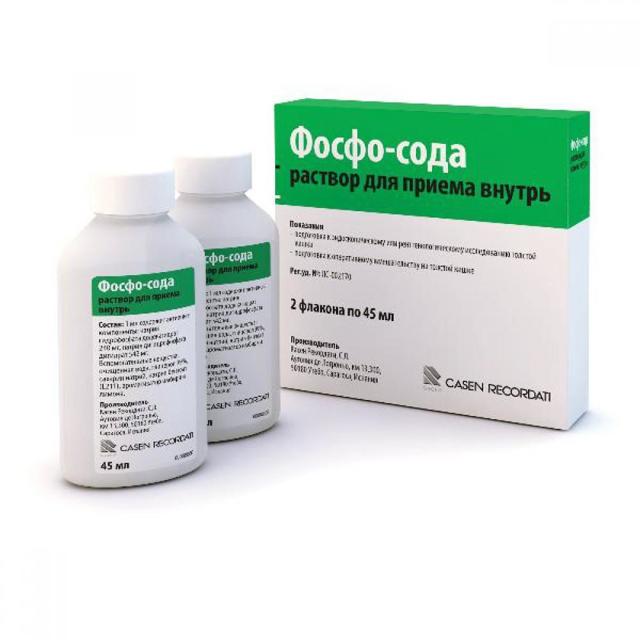
Despite the mild laxative effect, when using Microlax microenemas, undesirable consequences and side effects may occur:
- Strengthening the therapeutic effect (development of diarrhea for 24 hours or more);
- Pain around the navel or pulling in the lower abdomen with a false urge to defecate;
- Allergic reactions to the main components;
- Burning in the rectal lumen;
- Itching and mucous discharge from the anus.
Usually all side effects go away on their own after a few days. Colonoscopy itself can increase the negative consequences. We have already written about how intestinal colonoscopy is performed in a previous article. If you feel worse or increase unpleasant symptoms, symptomatic treatment is carried out.
It is unacceptable to use the product after the expiration date. The drug does not affect driving, concentration, or consciousness directly or indirectly.
Before visiting a proctologist, you need to find out what you need to have with you, how to prepare for the first appointment, what the doctor examines. You can make an appointment with a proctologist at the clinic reception or in a therapeutic area. A nurse or local therapist can tell you how to prepare for a diagnostic examination with a proctologist.
Dietary ration
In order to prepare before going to the doctor, the proctologist is required to adhere to a dietary diet. It is forbidden to eat dishes made from peas, beans, cabbage, as these products cause excessive gas formation and fermentation. Light foods are consumed 24 hours before the examination. Juices with pulp are also undesirable. In addition to dietary nutrition, thorough cleaning of the rectum is required. The accuracy of diagnosis depends on the cleanliness of the intestines.
Before the morning examination, you are allowed to have a light breakfast (12 hours before the examination). This can be weak tea with a sandwich or 200 ml of kefir. Diagnostics scheduled for lunch allows you to eat porridge with salad.
A few days before the instrumental examination, it is necessary to exclude spicy, fatty, salty, fried, and smoked foods from the diet. You cannot drink strong drinks in the form of coffee, strong tea, alcoholic beverages (even low-alcohol drinks, beer). Avoid homemade milk as well; grapes and cucumbers cause bloating. Also, the intestines are irritated by nuts, seeds, peppers, and citrus fruits.
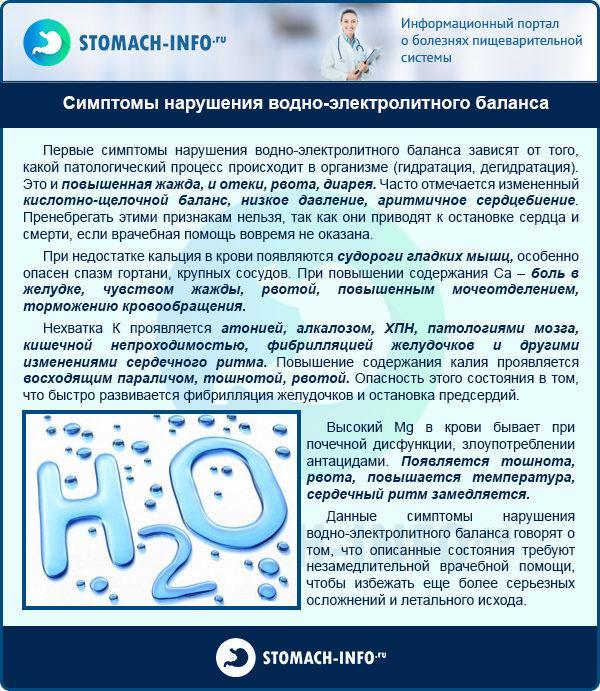
Baked goods with creams, jams, baked goods, and confectionery are excluded from the diet. Among the permitted products are:
- rice porrige;
- buckwheat;
- Hercules;
- mashed potatoes;
- lean meats (turkey, rabbit, chicken).
Cooking should be boiled, stewed, steamed, cooked in an oven, slow cooker, or double boiler. You can eat bagels, biscuits, mineral water without gas, uzvara, herbal teas.
Maintaining water balance
Before examining the rectal organ, there should be no swelling or heaviness. The organ must function normally and not be overloaded by cooking processes. Drinking plenty of fluids is necessary for problematic intestines. Thanks to an abundant drinking regime, beneficial substances are absorbed faster in the body, and the intestinal walls are not subject to dehydration. Water helps remove toxins and waste, cleanses intestinal pockets, prevents constipation, and softens stool.
During the day, an adult should drink at least 2.5 liters of plain water. But you should avoid fresh juices, tomato juice, oranges, and cocoa. It is allowed to drink rosehip decoction, compotes, fruit drinks, teas, green varieties (not strong) without restrictions. On the day of a medical examination by a proctologist, it is recommended to drink only water; if possible, it is better to exclude food.
Before an instrumental examination, a preparatory procedure is also required, consisting of a 5-day diet and thorough cleansing of the rectal organ. After an instrumental examination, the doctor will give further recommendations on the consumption of permitted foods. You can’t immediately pounce on food after a diet, otherwise your intestines will get a shock. An abrupt change of table threatens indigestion, heaviness, bloating, pain, and poor digestion of food.
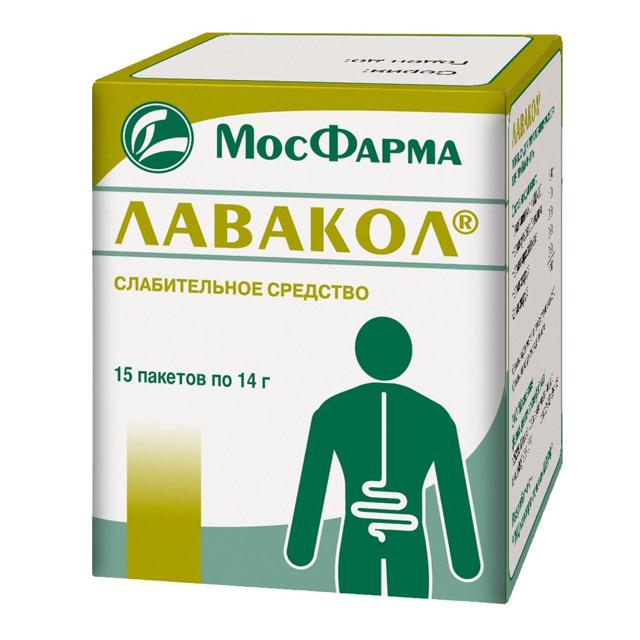
Examination of the colon, rectum and sigmoid intestine must be carried out annually for patients, especially for those people who have had a history of cancer in their family. Annual examinations are recommended from the age of forty. To avoid pathological processes, proctologists recommend balancing the diet, living actively, and eliminating pressure on the organs in the pelvis and anorectal area.
Meals before the examination
12 hours before the examination, complete abstinence from food is recommended.

A week before visiting the doctor, it is recommended to switch to liquid meals that are easily digestible. It is good to eat plant foods, except legumes.
This diet prevents constipation and blocks gas formation. During preparation, sweets, soda, yeast dough, and fast food are excluded from the diet.
Products that cause increased gas formation:
- all types of cabbage and root vegetables (broccoli, radishes, turnips);
- dairy products;
- bakery products;
- porridge;
- mushrooms;
- apples, pears, grapes
- spicy seasonings;
- confectionery;
- fatty meats and fish;
- alcoholic drinks, kvass.
All these products should be abandoned a few days before visiting the proctologist.
On the day of your visit to the clinic, in rare cases (if you have gastritis), you can drink a glass of unsweetened tea with biscuits.
When is it best to abstain from eating before your appointment?
If you have diseases of the gastrointestinal tract, such as colitis, ulcers with high or low acidity, irritable bowel syndrome, Crohn's disease, you should refrain from eating food on the day of visiting the proctologist.
Patients with a history of these diagnoses suffer from uncontrolled diarrhea, increased gas formation, and nausea. To conduct a complete and high-quality examination, it is better to refuse to eat food on the day of admission.
Preparation for examination by a proctologist for hemorrhoids with Microlax
HEMORRHOIDS is a disease associated with enlargement and prolapse of the choroid plexuses of the rectum and anus. Among the factors contributing to the development of hemorrhoids, the most significant are constipation, and vice versa, frequent diarrhea, sedentary work and a sedentary lifestyle, heavy physical labor and strength sports, pregnancy and childbirth, and alcohol abuse. Almost 70% of the adult population of the planet will experience hemorrhoids at least once in their lives.
There are four stages of internal hemorrhoids
- Stage 1 – there is bleeding without prolapse of nodes. Internal nodes are visible only during examination.
- Stage 2 – the nodes fall out after defecation and are reset back on their own.
- Stage 3 – the nodes fall out after defecation, but can only be adjusted by hand.
- Stage 4 - prolapse of the nodes not only after defecation, but also simply with a slight load and in an upright position of the body; manual reduction is ineffective - hemorrhoids are reduced for a short time, or are not reduced at all.
If you feel:
discharge of blood from the anus after defecation; prolapse of nodes (“bumps”) from the anus after stool and/or physical stress; feeling of incomplete emptying, sensation of a foreign body in the rectum; pain in the anus, discomfort and itching; mucus discharge from the anus, weeping in the anus.
You need to make an appointment with a proctologist!
The initial appointment includes:
- Physical examination of the patient
- Digital examination of the rectum
- Anoscopy
- Sigmoidoscopy
- Doctor consultation
PREPARATION FOR EXAMINATION BY A PROCTOLOGIST
First scheme:
MICROLAX is a laxative to prepare the intestines for examination. In microenemas.
- Rectally
- 1 microenema (5 ml) in the evening before the examination, 1.5-2 hours before bedtime.
- 1 microenema (5 ml) on the day of examination 1.5-2 hours before the doctor’s visit (possibly in the morning)
- Break off the seal on the tip of the tube.
- Lightly press the tube so that a drop of the drug lubricates the tip of the enema or lubricate the tip with Vaseline oil (to facilitate the insertion process)
- Insert the tip of the microenema all the way into the rectum.
- Squeeze the tube and squeeze out its contents completely.
- Remove the tip while continuing to gently squeeze the tube.
- If necessary, use during pregnancy and lactation (breastfeeding) does not require special precautions.
Second scheme:
On the eve of the study, in the evening at 19:00, a cleansing enema of 1-1.5 liters of water.
- The enema is repeated at 20:00. Enemas are performed in the lying position on the left side. Water at room temperature.
- Don't have dinner.
- Patients with diabetes have a light dinner.
- On the day of the examination: light breakfast at 9:00, cleansing enema 1-1.5 liters of water. The enema is repeated at 10:00.
Note: There are contraindications. Before use, you must read the instructions or consult a specialist.
source
Preparing for an appointment with a proctologist is a series of activities aimed at cleansing all parts of the intestines. Restriction of food intake, in some cases short fasting, cleansing enemas, and taking laxatives are indicated. To determine the problem, the doctor must see the condition of the mucous membranes and epithelium of all parts of the intestine. Therefore, it is necessary to empty the digestive organ before visiting a specialist.
This process lasts 2–3 days. You should limit or eliminate foods that can cause gas and diarrhea the day before the examination (legumes, cabbage, grapes). Two days before the visit, they refuse dairy products. At this time, they eat porridge with water, boiled lean meat, and fish.
The evening before the appointment and several hours before the examination, the intestines are cleansed with an enema. Doctors recommend using an Esmarch mug, a rubber bulb, and pharmaceutical microenemas. In some cases, you can limit yourself to taking laxatives.
They do not have dinner in the evening, and do not have breakfast on the day of the visit, especially after bowel cleansing. Sometimes, for stomach diseases, it is allowed to drink tea with biscuits.
This is a highly specialized specialist, a doctor who practices therapy for pathologies of the anus and all parts of the intestine.
Now such specialists are called coloproctologists, they are in every district clinic .
They are competent to diagnose and treat all pathologies of the intestinal tract.
Men and women can make an appointment with a specialist. The procedure is the same for both sexes.
The first appointment involves interviewing the patient to restore an accurate picture of the disease. All questions from a specialist should be answered accurately and truthfully.
After constructing an anamnesis (history of the disease), the proctologist will begin an examination. Purpose: to identify hemorrhoids, fistulas, anal fissures.
The examination takes place on a proctological chair (its design is similar to a gynecological one) or on a special couch; a knee-elbow position is used. At this stage, it is important to conduct a thorough diagnosis to rule out cancer.
Once the visual examination is completed, the doctor begins to palpate the anus.
The purpose of this procedure is to identify hemorrhoids, fissures, and determine anal tone.
The initial appointment for men also includes a prostate examination.
The procedure is carried out using special ointments with an anesthetic, wearing disposable medical gloves. Based on the results of the examination, the doctor makes a conclusion and prescribes appropriate treatment.
In order for the examination by a specialist to be as informative as possible, it should be approached thoroughly.
Proper preparation for the examination includes dietary restrictions (diet), cleansing of all parts of the intestines with an enema or laxatives.
1-2 days before the proctological examination, avoid eating foods that cause gas formation. Vegetables that contain a lot of fiber, such as cabbage, should also be avoided.
You should not eat yeast dough, carbonated drinks, or sweets. During this period, activated carbon is recommended - this can reduce gas formation.
The day before the appointment, cleanse the intestines. The method is selected by a specialist; consultation with a doctor is necessary. An enema, pharmacy microenema, and medicinal laxatives may be offered.
Experts recommend using an Esmarch mug before examining the intestines as the simplest but most effective method of cleansing it.
The enema is done at night and in the morning 2-3 hours before the appointment, and you should not have dinner or breakfast. In the evening, 2 enemas are given 3-4 hours apart.
Colon cleansing is carried out with warm water (2 l). A rubber container is filled with liquid, the temperature of which is +36...+37 ᵒC, the end of the tube is lubricated with Vaseline, and it is inserted into the anus. After about 15-20 minutes, the urge to defecate begins.
If there are problems in the anus (bleeding, advanced hemorrhoids), the enema should not be used. Laxatives are prescribed .
It is advisable to have a bowel movement early in the morning before visiting a doctor.
This drug is easy to use and quick-acting. The urge to defecate begins 20 minutes after administration. It is enough to carry out one morning procedure after consultation with a specialist.
According to indications, the Microlax enema can be prescribed in the evening. After the morning manipulation, eating and drinking are not recommended.
Bowel cleansing is an important step in preparation for an examination. This procedure allows the doctor to make the diagnosis as accurately as possible.
Cleansing procedures can be done in various ways:
- cleansing with enema and water;
- cleansing with pharmaceutical enemas;
- use of laxatives.
How to prepare and how to properly cleanse the intestines is decided after a preliminary consultation with a proctologist. In some cases, with bleeding, polyps, or anal fissures, enemas are contraindicated.
The doctor selects the most comfortable and less traumatic method of cleaning the rectum.
This procedure is mandatory for almost all patients. But with rare exceptions, manipulation is not carried out in emergency cases.
In what cases is bowel cleansing not done at home:
- with severe lesions of the colon, anus,
- if there is a risk of bleeding after the cleansing procedure;
- oncological neoplasms.
In these cases, enema cleansing can be replaced by taking laxatives after consultation with your doctor.
The most effective way is to empty the rectum using an Esmarch mug. After filling it with 2 liters of warm water or a weak infusion of chamomile, lubricate the tip of the device with Vaseline.
It is then injected into the rectal area. In this case, the person lies on his side with his knees tucked under him. As soon as all the liquid enters the body, the tube is removed, wait a quarter of an hour, and you can empty yourself.
The manipulation is carried out at night, before bedtime and in the morning before a visit to the proctologist. An enema allows the intestinal lumen to be cleared, and the medical examination does not bring discomfort to either the doctor or the patient.
Complete cleansing of the intestines is a guarantee of obtaining an objective picture of the disease.
These drugs are less effective and do not allow for complete cleansing of all parts of the intestine. Positive aspects: no outside help is required during the manipulation, quick effect.
Cleaning is done 1 or 2 hours before the clinical examination. After introducing the contents of the capsule, the effect occurs within 15-20 minutes. Sometimes, according to indications, the doctor prescribes an additional enema .
The drug is ready for use, located in a microenema tube. The patient should break off the wide end, then insert the tip of the tube into the anus and release the solution. After a quarter of an hour, they evacuate without effort.
These drugs are used without an enema; only a detailed consultation with a proctologist and gastroenterologist is necessary.
Laxatives have a number of side effects such as:
- diarrhea;
- bleeding;
- flatulence;
- intestinal cramps, colic, painful sensations appear.
They are used only as prescribed by a highly specialized specialist in order to avoid unpleasant consequences.
In modern medicine, laxatives based on macrogol are used. The substance prevents the absorption of fluid, which irritates the intestinal mucosa and leads to contractions. The drugs are produced in the form of saline solutions.
The advantage is a gentle effect on the intestines, easy emptying without strain. To prepare for examination and examination by a proctologist, use the drug Fortrans or Lavacol.
The products are used according to instructions in the evening. After bowel movement, a 12-hour fast is recommended before visiting a doctor.
A week before visiting the clinic, they switch to dietary nutrition and liquid food. Avoid legumes, cabbage, grapes, yeast dough, and carbonated water.
It is recommended to consume fermented milk products. Enema is contraindicated for patients with hemorrhoids . It is possible, on the recommendation of a doctor, to cleanse the intestines for hemorrhoids using Fortrans.
A week before the examination, you should consult a coloproctologist. It is possible that medications will be prescribed to relieve inflammation.
12 hours before the examination, complete abstinence from food is recommended.
A week before visiting the doctor, it is recommended to switch to liquid meals that are easily digestible. It is good to eat plant foods, except legumes.
This diet prevents constipation and blocks gas formation. During preparation, sweets, soda, yeast dough, and fast food are excluded from the diet.
Products that cause increased gas formation:
- all types of cabbage and root vegetables (broccoli, radishes, turnips);
- dairy products;
- bakery products;
- porridge;
- mushrooms;
- apples, pears, grapes
- spicy seasonings;
- confectionery;
- fatty meats and fish;
- alcoholic drinks, kvass.
All these products should be abandoned a few days before visiting the proctologist.
On the day of your visit to the clinic, in rare cases (if you have gastritis), you can drink a glass of unsweetened tea with biscuits.
If you have diseases of the gastrointestinal tract, such as colitis, ulcers with high or low acidity, irritable bowel syndrome, Crohn's disease, you should refrain from eating food on the day of visiting the proctologist.
Patients with a history of these diagnoses suffer from uncontrolled diarrhea, increased gas formation, and nausea. To conduct a complete and high-quality examination, it is better to refuse to eat food on the day of admission.
To reduce gas formation the day before the examination, you can drink activated carbon according to the instructions.
It is recommended to make an appointment in the morning. Prolonged fasting is not beneficial for everyone, so it is important to see a doctor in the morning.
If the appointment is scheduled for the afternoon, you must do an enema 3-4 hours before visiting the doctor. In the morning you can have a snack with biscuits and tea.
It is important to psychologically prepare yourself for visiting a proctologist . Modern examination methods do not cause much discomfort; most often they are painless.
The main thing is to trust the specialist and not be embarrassed by his presence. It is important to start treatment as early as possible if any health problems arise.
Most patients put off visiting a proctologist due to embarrassment. At the same time, pathologies dangerous to health and life develop.
In the modern world, cases of detection of oncology of the digestive organs are not uncommon. Such severe diseases can be cured in the early stages.
It is important not to miss their first symptoms and contact a good specialist in time, putting aside all embarrassment and indecision.
source
If you are planning an appointment with a proctologist, then it is advisable to prepare accordingly for the examination, that is, give a cleansing enema.
Let us immediately make a reservation that if you have severe pain (it hurts to give yourself an enema) or bleeding, then you do not need to give an enema before the initial medical examination. Do not injure the sore areas again. The doctor will carefully conduct the examination without this preparation. If necessary, you will be prescribed therapy to relieve exacerbation or pain, and after that you will undergo the necessary instrumental examinations.
In general, before the initial examination, the patient gives two cleansing enemas of 1.5-2 liters each, approximately 3-4 hours before the appointment, with a break between them of approximately 45 minutes, the water temperature is about 37 degrees. Also, you should not eat foods that cause flatulence the day before. If you have an appointment in the evening, but there is no way to prepare during the day, then a cleansing enema can be given after the morning bowel movement.
Now let's talk about how to give an enema correctly.
Cleansing enema
An important condition for high-quality diagnosis is thorough cleansing of the intestine from contents.
An Esmarch mug is used to perform a cleansing enema. It can be bought at almost any pharmacy. An Esmarch mug is a reservoir (glass, enamel or rubber) with a capacity of 1.5-2 liters. At the bottom of the mug there is a nipple onto which a thick-walled rubber tube is placed. For a rubber reservoir, the tube is its direct continuation. The length of the tube is about 1.5 m, the diameter is 1 cm. The tube ends with a removable tip (glass, plastic) 8-10 cm long. The tip must be intact, with smooth edges. It is preferable to use plastic tips, since a glass tip with a chipped edge can seriously injure the intestine. After use, the tip is washed well with soap under running warm water and boiled. Next to the tip on the tube there is a tap that regulates the flow of fluid into the intestines. If there is no tap, it can be replaced with a clothespin, clamp, etc.
For enemas, use only water from a proven source (one that is safe to drink). For children, it is better to use only boiled water. The water temperature is about 37-38 degrees. Colder water significantly increases intestinal motility and causes unpleasant pain. Using water with a temperature of more than 40 degrees for an enema is dangerous to health.
So, let's look at ways to give an enema.
Lie on the bed close to the edge on your left side with your legs bent and pulled towards your stomach. Place an oilcloth (plastic film) under your buttocks, and lower the free edge of it into a bucket in case you cannot hold water. Pour 1-1.5 liters of water at room temperature into Esmarch's mug, lift it up to a height of 1-1.5 m and lower the tip down to release a small amount of water and along with it air from the tube. Fill the tube (drain some liquid from the tube), then, without lowering the mug, close the valve on the rubber tube. Check if the tip is broken, lubricate it with Vaseline (soap, vegetable oil) and, spreading the buttocks, insert the tip into the anus with light rotational movements. The first 3-4 cm, insert the tip towards the navel, then another 5-8 cm - parallel to the tailbone. If there are obstacles and the tube rests against the intestinal wall or hard feces, remove it 1-2 cm and open the tap. Pressurized water will enter the large intestine. Almost immediately there will be a feeling of “fullness” in the intestines and an urge to stool. At these moments, you need to reduce the flow rate of liquid from the mug by closing the tap on the tube or squeezing it. Gentle circular stroking of the abdomen will help reduce discomfort.
If the tip is clogged with feces, it should be removed, cleaned and reinserted. If your rectum is filled with stool, try flushing it out with a stream of water. Esmarch's mug does not need to be completely emptied. Leaving a little water at the bottom to prevent air from entering the intestines, close the valve that regulates the flow of liquid and remove the tip.
Place a pre-prepared pad (cloth, repeatedly folded toilet paper, etc.) on the perineum, which must be pressed between the legs.
Get on all fours in the bathroom (knee-elbow position), leaning on one elbow, and insert the tip into the rectum with your other hand.
The tip must be inserted slowly and carefully, especially with hemorrhoids. Having inserted the tip, lower your head and shoulders lower and begin to breathe deeply, but not often, with your stomach, “sucking in air through your mouth or nose.” If not all the water has entered, and you already feel pain in the intestines, turn off the tap on the hose and breathe deeply.
When the water in the mug runs out, remove the tip and place a pre-prepared pad on the anus.
It is advisable to hold the water for 10 minutes. To do this, lie on your back and breathe deeply. Soothe the pain and feeling of fullness in the abdomen with stroking. If possible, walk around with the water injected or lie on your stomach. When administering a cleansing enema, you need to ensure that no more than 1.5-2 liters of liquid are administered at a time. If it is necessary to give two enemas in a row, you should maintain an interval of 45 minutes to 1 hour between them, making sure that the rinsing water from the first enema has completely drained.
Cleansing enema substitute
If you have difficulty administering an enema, there is an excellent alternative - the drug Microlax.
Microlax is a ready-made saline laxative solution in microenemas of 5 ml for single rectal administration, 4 pcs. packaged. The laxative effect of using this drug occurs 5-20 minutes after administration.
To prepare the intestine for examination, it is enough to use 2 microenemas. As a rule, emptying occurs 15-20 minutes after rectal administration of the 1st microenema; after emptying, the 2nd microenema is administered. If after the introduction of the 2nd microenema there is no bowel movement, then you managed to prepare for the first one.
Microlax acts gently, without irritating the intestines and without causing systemic side effects. Considering the safety of Microlax, it is recommended for adults and children, as well as for pregnant and lactating women.
Rules for using Microlax:
1. Break off the seal on the tip of the tube;
2. To facilitate the administration process, you need to lightly press the tube so that a drop of the drug lubricates the tip of the enema;
3. Insert the tip of the microenema into the rectum;
4. Squeezing the tube, squeeze out its entire contents;
5. Remove the tip while continuing to lightly squeeze the tube.
PROMOTION! SIGN UP FOR A CONSULTATION AND RECEIVE A 50% DISCOUNT!
source
MAKE AN APPOINTMENT 8(495)304-30-40 TELEPHONE FOR INFORMATION 8(495)304-30-39 APPOINTMENT SCHEDULE
Before the initial consultation with a coloproctologist, it is necessary to prepare for the examination - to clear the final sections of the colon of contents. This is necessary so that the information obtained as a result of the initial consultation is as complete as possible. It should be remembered
that
if the reason for your visit is severe pain in the anal area, then preparation for an examination by a proctologist is not required
. It is enough if you have a bowel movement that day. The proctologist surgeon will carefully conduct the examination without special training. If necessary, you will be prescribed therapy to relieve exacerbation or pain, and after that you will undergo the necessary instrumental examinations.
In all other cases, including painless bleeding from the anus
, before the initial examination, no later than 3-4 hours before the appointment, you should prepare for the examination by a coloproctologist, that is, cleanse the lower part of the intestine. The most famous way to do this is to perform two cleansing enemas of 1-2 liters each with an interval of approximately 35-45 minutes between them. There are also alternative ways to prepare for an examination by a proctologist, which are described below.
On the eve of the examination, you should not eat foods that cause flatulence, if you know any. Most often these are cabbage, grapes, apples and flour, and if you still notice flatulence, you can take 3-4 tablets of activated carbon. The effect of taking the sorbent will be better if you grind it first. If you have an appointment in the evening, but during the day it is not possible to give enemas, then prepare for the examination
maybe in the morning. In this case, before taking it, it is advisable to limit food intake to a minimum - not strong tea, eggs, chocolate.
Method of performing a cleansing enema
To perform a cleansing enema, the so-called "Esmarch's mug." This is a reservoir (glass, enameled, often rubber or disposable plastic) with a capacity of 1.5-2 liters. At the bottom of the tank there is a nipple, onto which a rubber tube is placed, which ends in a removable tip (usually plastic) 8-10 cm long. The tip must be intact, with smooth edges. After use, the tip is washed well with soap under running warm water and boiled. There is a valve on the tube next to the tip that regulates the flow of fluid into the intestines. If there is no valve, it can be replaced with a clothespin, clip, etc.
For enemas, use only drinking water. Water temperature is about 25-28 degrees. Colder water significantly increases intestinal motility and can cause unpleasant pain. It is not advisable to use water at body temperature or higher for an enema, since at this temperature the water is absorbed too quickly in the intestine.
When everything is ready for the enema, you can begin.
Pour 1-1.5 liters of water at room temperature into Esmarch's mug, lift it up to a height of 1-1.5 m and lower the tip down to release a small amount of water and along with it air from the tube. Fill the tube (drain some liquid from the tube), then, without lowering the mug, close the tap on the rubber tube. Lie on the bed close to the edge on your left side with your legs bent and pulled up to your stomach. Place an oilcloth (plastic film) under your buttocks, and lower the free edge of it into a bucket in case you cannot hold water. Lubricate the tip with Vaseline (baby cream, vegetable oil) and, spreading the buttocks, insert the tip into the anus with light rotational movements. For the first 3-4 cm, insert the tip towards the navel, then another 5-8 cm - parallel to the tailbone, slightly “raising” the outside part of the tip towards the perineum. If there are obstacles and the tube rests against the intestinal wall or hard feces, remove it 1-2 cm and open the tap. Pressurized water will enter the large intestine. Almost immediately there will be a feeling of “fullness” in the intestines and an urge to stool. At these moments, you need to reduce the flow rate of liquid from the mug by closing the tap on the tube or squeezing it. Gentle circular stroking of the abdomen will help reduce discomfort.
If the tip is clogged with feces, it should be removed, cleaned and reinserted. If your rectum is filled with stool, try flushing it out with a stream of water. Esmarch's mug does not need to be completely emptied. Leaving a little water at the bottom to prevent air from entering the intestines, close the valve that regulates the flow of liquid and remove the tip.
It is advisable to hold the water for 10 minutes. To do this, lie on your back and breathe deeply. Soothe the pain and feeling of fullness in the abdomen with stroking. If possible, walk around with the water injected or lie on your stomach. When administering a cleansing enema, you need to ensure that no more than 1.5-2 liters of liquid are administered at a time. If it is necessary to give two enemas in a row, you should maintain an interval of 35-45 minutes between them, making sure that the rinsing water from the first enema has completely drained.
Alternative ways to prepare for a proctologist examination
If you have difficulty administering an enema, or simply don’t want to “mess around,” there are several alternatives:
Microlax is a ready-made local laxative solution in 5 ml tubes for single rectal administration - 4 pcs. packaged. The effect of using Microlax occurs 5-15 minutes after administration. Using the drug, it is easy to clean the distal 20-30 cm of the intestine, which is enough for a full examination and sigmoidoscopy. The method of application and the release form are such that, following the instructions, you can prepare for inspection in almost any conditions where there is a bathroom - including at work, etc.
Microlax acts gently, without irritating the intestines and without causing systemic side effects. Considering the safety of Microlax, it can be used by adults and children, as well as during pregnancy and lactation.
Directions for using Microlax: break off the seal on the tip of the tube. To facilitate the administration process, you need to lightly press on the tube so that a drop of the drug lubricates the tip of the enema. Then you should insert the tip of the microenema into the rectum and, squeezing the tube, squeeze out its entire contents. Remove the tip while continuing to gently squeeze the tube.
To prepare the intestine for examination, it is enough to introduce 2-3 tubes with an interval of 5-10 minutes. After administration of the drug, emptying usually occurs within 5-20 minutes. If after the introduction of the 2nd microenema there is no emptying, then you should not be upset - this means you managed to prepare the first time and there is no content in the intestine. If after two microenemas you have doubts about the cleanliness of the intestine, you can administer it a third time. Microlax should be used to prepare for the examination no later than 3 hours and no earlier than 6 hours before the examination.
Preparation with Fortrans is the most effective way to cleanse the intestines to obtain maximum results during the examination. As practice shows, a one-time dose of Fortrans is equivalent to three enemas with activated carbon. Preparation with Fortrans or another drug containing the active substance Macrogol before the examination will allow you to properly cleanse the body at home.
According to the instructions for use, the dosage of Fortrans is directly proportional to body weight. You need to take 1 liter of the drug solution per 20 kg of weight. Preparing such a solution is very simple. A packet of Fortrans powder dissolves in a liter of purified drinking water. The resulting solution should be taken orally, 200 ml every 15-20 minutes. Advice:
Gradual use of this medication is very important.
This helps soften stool and completely painlessly remove it from the body. Start drinking Fortrans the day before the examination. However, the first dose of the medicine should be no later than 18 hours before. The instructions advise drinking the solution in two doses, that is, it should be used in the morning and evening. If the examination time is scheduled in the morning or early afternoon, you must drink Fortrans the night before in one dose. If after lunch, then take the drug in two doses.
Recommended dosage regimen for Fortrans
For more effective proper bowel cleansing, you must adhere to the following solution intake regimen:
It is necessary to take the drug on time
· At 12.00 the day before the colonoscopy, the last meal is recommended;
· From 14.00 to 15.00 you need to drink 1 liter of the drug;
· From 15.00 to 16.00 – take another liter of Fortrans;
· From 17.00 to 19.00 you should take 2 liters of solution.
As you can see, Fortrans is used every 15 minutes, one glass. Before preparing the solution, consult your doctor about the best way to drink it.
The effect of the drug begins one and a half hours after administration. If nothing happens within three hours, you should do a gentle abdominal massage and walk around a bit. If the solution is taken again in the morning, then cleansing occurs within half an hour.
The powder for preparing the solution must be diluted carefully and strictly according to the instructions. Otherwise, you will have to buy this expensive medicine again. The annotation states that one package of the drug must be diluted with water in a volume of 150-200 milliliters. Stir the solution thoroughly until it reaches a homogeneous consistency. Take your medicine. The dosage of the laxative depends on the age of the patient. The instructions contain the following recommendations: children 1-2 years old, 0.25 packets in the morning and afternoon; from 2 to 4 years - half a packet in the morning and throughout the day; at 4-9 years old use 1 packet in the morning and 0.5 in the afternoon; children over 9 years old and adult patients take 1 packet the day before the procedure (in the evening) and 8 hours later (in the morning). You need to drink as much fluid as possible while using the Picoprep medication. When the medicine begins to work, frequent bowel movements occur. Often it acquires a liquid consistency and resembles diarrhea. To replenish the lack of water, you need to drink. Sometimes the patient is additionally prescribed rehydration therapy. Please note that the prepared solution cannot be stored.
The day before the test, instead of breakfast, drink a glass of liquid, immediately after that take 45 ml of Flit dissolved in 120 ml of water. Wash down the solution with a glass of cool water (or any clear liquid).
Instead of lunch, drink 2-3 glasses (more is possible) of clear liquid to suit the patient's taste. It could be water, weak tea, weak broth.
In the evening, instead of dinner, you should again drink 250 ml of any liquid (at approximately 19:00) and take a second dose of the medicine (45 ml), which should again be washed down with a glass of cool water.
Preparing for a colonoscopy with the help of the drug Fleet, if the procedure is scheduled after lunch.
The day before the colonoscopy, you can have a light breakfast and allow a light lunch at 12-13 o'clock. After 13:00 you cannot eat (you can drink without restriction).
At 19 o'clock, replace dinner with a glass of liquid, take 45 ml of Flit dissolved in 120 ml of water and wash it down with a glass of cool water. After “dinner” during the evening, the patient should drink at least 750 ml of liquid (any).
On the morning of the procedure, take another dose according to the same regimen.
Another option for a topical saline laxative in a ready-to-use package with a lubricated tip. Like Microlax, its action is based on osmotic fluid retention in the intestinal lumen. This leads to a significant increase in peristalsis, an immediate increase in mucus production and bowel movement.
Every 135 ml of the drug contains: Sodium dihydrogen phosphate 21.6 g
Sodium hydrogen phosphate 8.1 g Excipients: Sodium benzoate 0.54 g, Purified water, sufficient amount up to 135 ml.
Directions for use: It is better to lie on your left side so that your right leg is bent at the knee joint, or both legs are bent in a knee-chest position. Remove the protective cap from the bottle and smoothly insert the tip into the rectum. By squeezing the balloon bottle, introduce the liquid into the intestines. Remove the tip from the rectum. It is necessary to maintain this position for 2-5 minutes until the urge to defecate appears.
It is best to prepare 2-3 hours before your appointment. As a rule, one administration is sufficient, however, if there are doubts about the results of the preparation, the manipulation can be repeated 15-25 minutes after emptying.
Regardless of whether you were able to prepare or for some reason you were unable to do so, before examining a proctologist, your psychological attitude is very important. You should not be afraid of inspection. If something scares you, think about where the fear of being examined by a doctor comes from? Especially if you are going to a proctologist for the first time and you do not yet have any objective data about the features of the examination. If an inspection scares you “as it is” or “just like that,” think about it: is it worth being afraid of something abstract that you don’t know? Or the fears did not arise out of nowhere, but you read somewhere negative information that “a visit to a proctologist is terrible”... Believe me, rumors about the “horrors” of an examination by a proctologist are greatly exaggerated. Even if you are very sensitive or have pain, our doctors have extensive experience and are sufficiently qualified to conduct the examination as comfortably as possible for you, performing local anesthesia if necessary.
The quality of the tools also plays an important role. From all the variety of diagnostic equipment, we have selected the best. It is produced by the most famous foreign companies and is designed to reduce discomfort from the examination to a minimum. If you are shy about a male doctor or a female nurse, you will be provided with special disposable examination shorts in which you will feel comfortable and safe. Perhaps this is also why quite often after an examination one hears: “And that’s ALL?!” And I expected (a) something terrible...”
An examination by a proctologist is safe, easily tolerated by patients and provides maximum information for making an accurate diagnosis, which is the key to successful treatment.
source
The remaining stages of preparation for an appointment with a proctologist
To reduce gas formation the day before the examination, you can drink activated carbon according to the instructions.
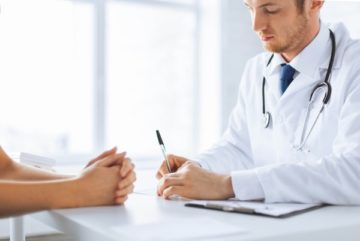
It is recommended to make an appointment in the morning. Prolonged fasting is not beneficial for everyone, so it is important to see a doctor in the morning.
If the appointment is scheduled for the afternoon, you must do an enema 3-4 hours before visiting the doctor. In the morning you can have a snack with biscuits and tea.
It is important to psychologically prepare yourself for visiting a proctologist . Modern examination methods do not cause much discomfort; most often they are painless.
The main thing is to trust the specialist and not be embarrassed by his presence. It is important to start treatment as early as possible if any health problems arise.
Preparation for sigmoidoscopy with Microlax: how the study works
In the presence of intestinal pathologies, the correct conclusion can be made only by resorting to instrumental diagnostic methods. One of the most popular techniques is the procedure for examining the inner surface of the intestine.
Sigmoidoscopy (rectoscopy) is an endoscopic examination of parts of the intestine located at a distance of up to 35 cm from the anus. A visual inspection is done using a sigmoidoscope. This method is used as a mandatory element of a proctological examination. Patients who have reached the age of 40 are recommended to undergo annual examinations.
During this manipulation, the following options appear:
- detection of malignant neoplasms;
- assessment of the intestinal walls for their elasticity, muscle tone and features of the vascular pattern.
Even microscopic neoplasms that are not detected by other methods can be detected with its help.
The sigmoidoscope is a multifunctional and integral tool for proctological examination.
The device includes a metal tube with a diameter of 10 to 20 mm, with a built-in lighting device, an air supply mechanism and optical glasses.
In addition to examining the intestines, the instrument allows you to perform the following manipulations:
- remove foreign objects;
- do a biopsy;
- remove polyps;
- perform vascular coagulation.
Depending on the symptoms present, rigid or flexible instruments are used.
The specialist prescribes a study if the patient has the following manifestations of intestinal diseases:
- discomfort in the anal area;
- haemorrhoids;
- regular bowel disorders;
- periodic constipation;
- discomfort during bowel movements;
- purulent discharge from the anus;
In the presence of inflammatory bowel processes, this manipulation is included in the list of mandatory measures.
Using a proctoscope, proctosigmoiditis, fissures, polyps, ulcerative colitis, benign and malignant neoplasms are detected.
Sigmoidoscopy allows you to examine the rectum and sigmoid colon
Sigmoidoscopy is an accessible method of examining the intestines, with virtually no contraindications. An examination is not advisable if the following processes or diseases are present:
- bleeding from the anus;
- mental disorders;
- acute paraproctitis;
- large anal fissures;
- heart failure;
- narrowing of the intestinal lumen;
- peritonitis.
If there is a need for emergency research, the procedure is performed under local anesthesia.
Due to the fact that stool makes diagnosis difficult, you should cleanse your intestines before visiting the doctor. To ensure an accurate diagnosis, the proctologist recommends that the patient follow a slag-free diet for several days before the procedure.
A reliable result can be obtained only with proper preparation for rectoscopy
Since therapeutic nutrition is short-term, it has no contraindications. The only exception is individual intolerance to a particular product. The main principle of the diet is to avoid rough foods and focus on easily digestible foods.
Table 1. Recommended and prohibited products
It is impossibleIt is possible
- fatty fish;
- potato;
- mutton;
- pork;
- duck;
- strong black tea;
- spices;
- dairy products with a high percentage of fat content;
- confectionery;
- black bread;
- pasta;
- coffee;
- pearl barley porridge;
- chocolate;
- beer and kvass;
- legumes;
- nuts;
- soda;
- alcohol;
- rich juices.
- lean fish and meat;
- steamed vegetables;
- low-fat fermented milk products;
- herbal teas;
- unsaturated juices.
It is preferable to process products using the steam method.
3 days before the procedure:
- Breakfast: 200 ml tea, oatmeal, 1 piece of toast.
- Second breakfast: 250 ml low-fat fermented baked milk.
- Lunch: chicken broth, 2 steamed meatballs, cucumber salad.
- Afternoon snack: cottage cheese casserole and compote.
- Dinner: biscuits and 250 ml of low-fat kefir.
In 2 days:
- Breakfast: hibiscus, buckwheat, 1 slice of white bread.
- Second breakfast: 250 ml of dairy products.
- Lunch: steamed sea fish, rice porridge and juice.
- Afternoon snack: low-fat yogurt.
- Dinner: tea and semolina porridge.
For 1 day:
- Breakfast: 1 soft-boiled egg, toast and fruit compote.
- Lunch: green tea, broth and low-calorie cookies.
Due to the fact that therapeutic nutrition is designed solely for cleansing the body, it is recommended to reduce physical activity. The diet will help stabilize intestinal activity and reduce the formation of gases.
Cleaning methods
It is possible to cleanse the rectum through the use of medications with a laxative effect or enemas. A positive result is achieved in both cases. The patient chooses a cleansing method based on the individual characteristics of the body.
After 2 hours after lunch, the patient should proceed to bowel cleansing
Fortrans
A safe product that does not affect the state of microflora and chemical processes in the body. By slowing down the process of fluid absorption, stool softens and comes out.
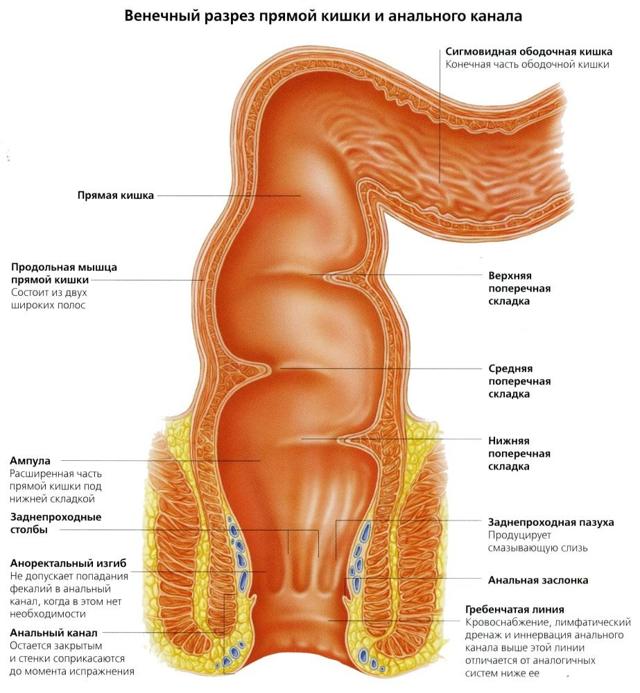
"Fortrans" makes it possible to cleanse the intestines comfortably
The advantage is the absence of discomfort during bowel movements. Among the disadvantages is the risk of allergic reactions. This drug is not recommended for patients with renal pathologies, acute intestinal obstruction and heart failure.
Reception features:
- To avoid dehydration, you need to take in plenty of fluids.
- Directions for use: 1 packet per 20 kg of weight. If, for example, 3.5 bags are needed, round up to 4.
- The powder should be diluted with 1 liter of drinking water and drunk in small sips for 1 hour.
- A slice of lemon will relieve the unpleasant aftertaste and nausea.
- If the patient experiences frequent vomiting, you should take Motilak in advance.
Depending on the time of the manipulation, there are 2 schemes for using Fortrans.
Table 2. Fortrans dosage regimens
Time of dayRecommendations
| Morning | The final meal is no later than 12 hours before the day of examination. The patient is then allowed to drink light chicken broth or juice. In the evening you need to drink 2 packets, take a 60-minute break and finish the remaining packets. As a rule, the urge to defecate appears 60 minutes after taking the first portion and ends 3 hours after consuming the final sachet. |
| After lunch | 2 packets of Fortrans should be consumed after 6 pm 1 day before your visit to the doctor. The remaining dose should be taken early in the morning. |
Fleet phospho-soda
The drug perfectly softens feces and is not absorbed by the circulatory system. Contraindications for use are identical to Fortrans. It is also undesirable for patients on a salt-free diet to take the drug.

“Fleet phospho-soda” is an analogue product to Fortrans
Table 3. Features of taking “Fleet phospho-soda”
Time of dayRecommendations
| Morning | 1 day before the procedure, you are allowed to drink 250 ml of chicken broth, herbal tea or unsaturated juice for breakfast. At the end of the meal, you should consume 1 bottle of the product, previously diluted in 130 ml of liquid. The drug should be washed down with 250 ml of warm water. For lunch - 500 ml of broth or juice, for dinner - the amount of liquid is reduced to 250 ml. After the evening meal, you need to take a second portion of the product. |
| After lunch | 1 day before the examination, for lunch you can enjoy foods from the permitted list: boiled egg, kefir, toast or semolina prepared without adding milk. For dinner - 200 ml of liquid, after which you should take 1 bottle of medicine. For breakfast on the day of the doctor's visit - 1 glass of broth and a second portion of the drug. |
The product must be taken in the indicated dosage. Failure to follow the rules can lead to disruption of the body’s water and electrolyte balance.
Symptoms of water and electrolyte imbalance
Lavacol
The principle of the effect on the body and contraindications of the drug are similar to the previous ones.
The slightly salty taste of Lavacola can be effectively eliminated with sweet syrup or honey.
Table 4. Features of taking Lavacol
Time of dayRecommendations
| Morning | The day before your visit to the doctor, the first two meals can be varied with liquid porridges and broths. The product should be taken from 4 pm, consuming each serving at intervals of 15 minutes. You are allowed to drink liquid while taking the medicine. |
| After lunch | The first use of Lavacol begins at 6 pm. The remaining 3 packets should be drunk at 6 a.m. on an empty stomach. |
Duphalac
The product activates peristalsis and quickly dilutes the intestinal contents.
Duphalac is approved for use by all patients, regardless of age groups
Reception features:
- The day before the study, 1 boiled egg and liquid porridge without milk were allowed as breakfast.
- It is permissible to drink liquid at lunch.
- 3 hours before the procedure, you need to drink 200 ml of the product diluted in 2 liters of liquid in small sips.
Microlax
The drug belongs to the category of mini-enemas.
Microlax allows you to “wash” the distal part of the intestine
Reception features:
- Easily digestible foods are allowed at lunch.
- In the evening you need to use 2 tubes of Microlax with an interval of 15 minutes.
- On the morning of the examination, another tube is placed.
- The process of defecation begins 15 minutes after using the product.
When using drugs with a laxative effect, it is advisable to massage the stomach and move actively.
Almost any endoscopic examination requires preliminary preparation from the patient, which may include diet, medication, or bowel cleansing.
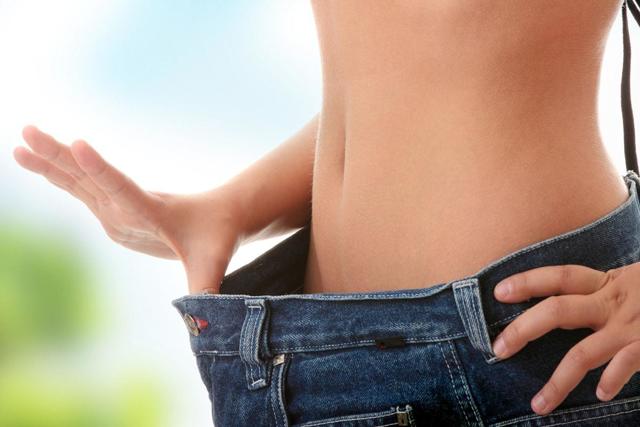
In some cases, preparation for sigmoidoscopy is carried out using Microlax. This is a medicinal substance contained in a small enema and has a mild laxative effect.
Microlax is a disposable microenema that has proven safety and contains a fast-acting laxative. The main focus of the local drug is to eliminate constipation, which occurs in almost 50% of people of different ages.
The substance that is in the microenema is a viscous, colorless and slightly opalescent liquid. It contains 70% sorbitol solution, sodium citrate, purified water, sodium lauryl sulfoacetate and sorbic acid.
Microlax is available in the form of a special solution for rectal administration, 5.0 ml in each polyethylene tube. A whole cardboard pack can contain 4 or 12 microenemas along with an instruction insert. The product has many positive reviews.
Preparation with enemas
At the doctor
When is a consultation with a proctologist required?
The most common (and quite severe) disease of the rectum is hemorrhoids . This is an expansion of the lumen of the venous arteries that form the hemorrhoidal plexus of the anus. Dilated veins often become inflamed, which causes intense pain, which intensifies after defecation, physical activity and prolonged sitting on hard surfaces. If the inflamed vessels and capillaries are damaged, the patient may notice the appearance of scarlet blood on the underwear or the surface of the feces after bowel movements.
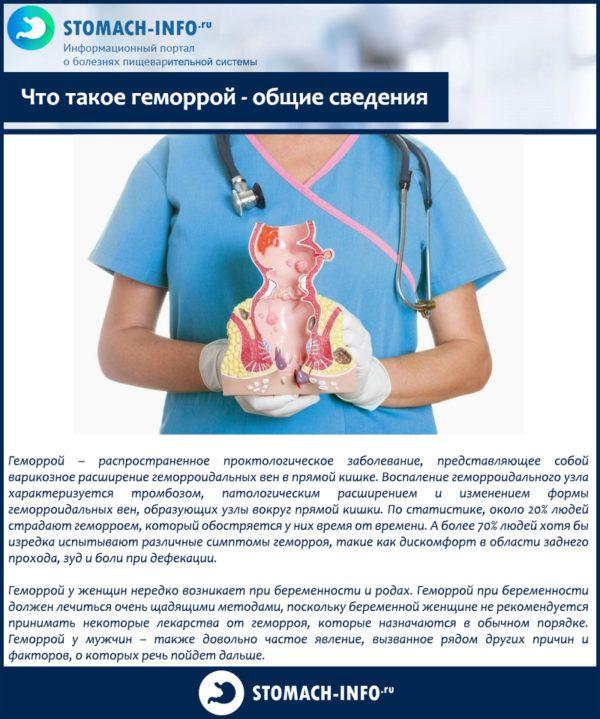
What are hemorrhoids - general information
Consultation and preventive examination by a proctologist are necessary for patients at risk for developing hemorrhoids. These are women during pregnancy and after childbirth, office workers, heavy smokers, and people with alcohol and drug addictions. An examination by this specialist may be indicated for athletes, especially if they engage in strength sports associated with constant tension in the abdominal muscles and straining.
The second most common pathology of the anus in people of different ages is proctitis . This is an inflammatory process in the mucous membrane of the rectum, which can be caused not only by infections, but also by injury from a foreign object (for example, toys intended for anal sex), as well as dietary errors. An abundance of fatty and spicy foods in the diet, insufficient drinking regimen - all this can cause inflammation and irritation of the intestinal walls.
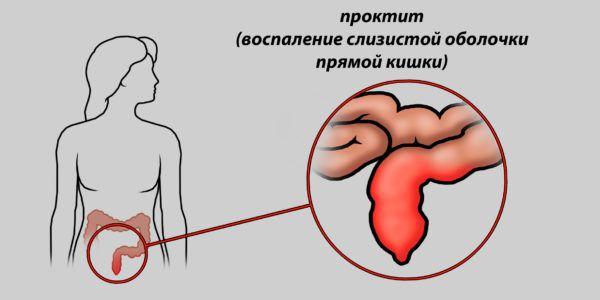
A type of proctitis is paraproctitis , a disease in which the layer of perirectal tissue is involved in the inflammatory process. The disease occurs in 40% of patients, in about half of them the symptoms are not very pronounced, so they do not seek medical help, which often causes severe complications.
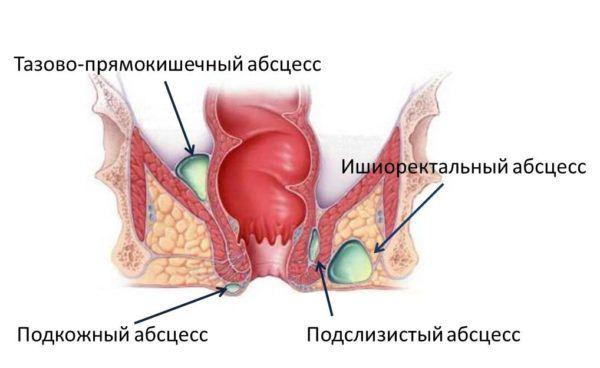
An examination by a proctologist will also help to identify or suspect the following diseases and pathologies:
- colorectal cancer (malignant lesion of the large intestine or anus);
- anal fissure and fistulas;
- perirectal abscess;
- rectal polyps;
- cysts and tumor formations.
If a foreign body gets stuck in the anus, the doctor will be able to remove it using instruments.
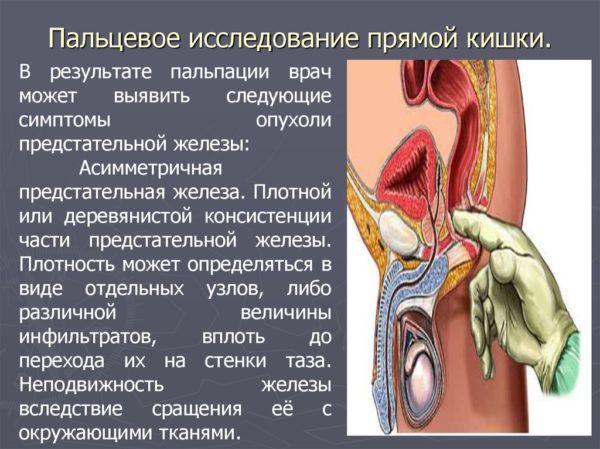
Digital examination of the rectum
First impressions of using Microlax in coloproctology
Andrianov A.V. Consultative and outpatient department of OJSC Samara Diagnostic Center
Enemas are often used in the treatment of patients of various profiles.
Types of enemas used in medicine are most fully presented in the works of A.M. Aminev. Despite the centuries-old history of the use of enemas, their undoubted benefits when performed correctly according to strict indications, many patients and medical workers are reluctant to prescribe them, and especially to perform them. As a rule, this is associated with prolonged flatulence, incomplete bowel movements, pain and discomfort in the abdominal cavity, etc.
More recently, a new remedy for the treatment of constipation has appeared on the pharmaceutical market - Microlax (M) in the form of microenemas, Pharmacy Corporation (USA). Manufacturer: Pharmacy and Upjohn AB, Stockholm, Sweden. 1 ml of the drug contains sodium citrate 90 mg, sodium lauryl sulfoacetate 9 mg, sorbic acid (E200), glycerin, sorbitol. 1 tube contains 5 ml of the drug.
The characteristics given in the advertising brochures and annotations accompanying the drug immediately attracted our attention to Microlax:
— guaranteeing complete control — the effect occurs within 5-15 minutes; — safety of operation; — possibility of use in pregnant women and young children; — no contraindications; - non-addictive; — convenient and hygienic to use.
Indications for use of Microlax:
- treatment of constipation; — preparation for operations, X-ray and instrumental studies; - use in the postoperative period.
We analyzed the use of Microlax in 160 patients who applied to the outpatient coloproctology department of the Samara Diagnostic Center. The results obtained exceeded all expectations. We were convinced of the reliability and safety of Microlax, clarified and expanded the indications for its use in coloproctology. We emphasize the last circumstance because We are convinced that Microlax can be used in other branches of medicine.
There were 129 women (80.6%), 31 men (19.4%). Age ranged from 4 months to 78 years. 2 (1.25%) experienced a short-term superficial burning sensation in the rectum. The drug was well tolerated and received enthusiastic reviews from patients about its use, especially from those who had previously used various types of enemas and had the opportunity to compare them.
In 58 patients, Microlax was used to prepare for sigmoidoscopy (RRS) in 2 variants. It was applied to 30 patients within an hour (30-40 minutes) before instrumental examination. The overwhelming majority of these were residents of rural areas, out-of-town patients who did not know that they were indicated for RMS and that they needed to prepare for it accordingly. In 2 patients from this group the effect was within 40 minutes. did not occur, a second tube of Microlax was applied, after 10 and 15 minutes. the effect was achieved. After 30 and 40 minutes. RRS was performed. In 28 patients, Microlax was used according to the following scheme: 1 tube at night, about an hour before bedtime, the second - an hour before the examination.
The examination was performed in all patients. In 3 patients (1st preparation option), the existing traces of fecal residues were not an obstacle to RRS. We noted that the features of the endoscopic picture in RMS were constantly observed: slight pallor, dullness of the mucous membrane and the presence of traces of liquid (mucus) of a light cloudy color with a whitish tint.
In 40 patients, Microlax was used to prepare for ultrasound of the pelvic organs (gynecology department). Classical preparation consisted of using cleansing enemas according to the standard scheme. These were patients who came for a consultation without an appointment or prior bowel cleansing. Previously, in a similar situation, consultations were postponed to other days. In this group, after using Microlax (1 dose), an ultrasound was performed. There was no decrease in the quality of studies.
In 15 patients, Microlax was used in the conservative complex treatment of acute and chronic anal fissures. Many authors have noted the positive effect of cleansing enemas on the healing of anal fissures. We also, without fail, use cleansing enemas called “counter” - “towards the urge”, as one of the main components in the complex of conservative measures, but in the amount of 400.0-600.0. We noticed this component on Microlax (5 ml). The aesthetic appearance of the enema, ease of use, significantly smaller volume of the administered drug, consistently constant effect in the form of abundant, soft, much less painful bowel movements, make the use of Microlax preferable instead of a cleansing enema.
In 14 patients, Microlax was used in the postoperative period after hemorrhoidectomy, excision of anal fissures and perirectal fistulas. Microlax successfully replaced cleansing “counter” enemas for the treatment of existing postoperative wounds of the anal canal.
In 13 patients, Microlax in an amount of 5 ml was successfully used for preoperative preparation for “minor” proctological operations (excision of anal fissures, intrasphincteric pararectal fistulas, hemorrhoids, genital warts).
In 6 patients with anorectal thrombosis, accompanied by severe pain during defecation, the administration of Microlax significantly reduced its intensity.
Finally, Microlax was used in 2 children under 1 year of age (4 and 8 months). The positive effect was achieved after 5 and 10 minutes. Microlax is applied in the amount of 1/3 of the tube.
We cannot confirm that Microlax is not addictive in the treatment of constipation, as the developers of this drug claim. This requires a longer observation period. But we can definitely say that it works flawlessly for 12-15 days.
Thus, Microlax, in our opinion, is truly a perfect and modern remedy for the treatment of constipation. Let us take the liberty of asserting that where there are indications for prescribing a cleansing enema, Microlax should be prescribed.
In conclusion, I would like to draw the attention of domestic pharmaceutical manufacturers to the need for the development and mass production of similar analogues of Microlax, as microenemas, for example, with sea buckthorn oil, pumpkin oil, rosehip oil, etc.
Symptoms for which you need to contact a proctologist
Preventative examinations by a proctologist are recommended for people over 60 years of age, as well as for patients whose immediate blood relatives have had colorectal cancer or malignant tumors of the gastrointestinal tract. The remaining patients turn to this specialist only when painful symptoms occur or upon referral from a local physician if they suspect rectal pathology.
There are several dangerous signs that require consultation/examination by a specialist and are likely to indicate inflammatory, tumor or infectious processes in the anus. These include:
- pain when sitting, straining, lifting heavy objects, concentrated in the anus (may increase with coughing, hiccups and sneezing);
- painful bowel movements;
- changes in the color, smell and consistency of feces;
- dry and hard feces, looking like separate dense lumps;
- blood on the surface of the stool or inside the stool;
- pain during the passage of excrement through the rectum;
- mucus, pus, white spots in feces.
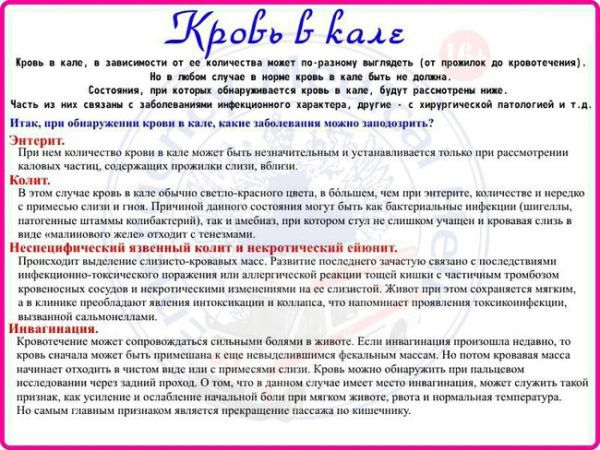
Important! A dangerous sign is the appearance of black, unformed stool with a liquid consistency. This symptom may be a manifestation of hidden gastric or intestinal bleeding. The blood coagulates under the influence of the platelet mass and takes on a dark color, leaving the rectum in the form of a jelly-like thick mass. Hidden bleeding is a deadly condition in which it is necessary to urgently hospitalize the patient in the surgical hospital of the proctology department.
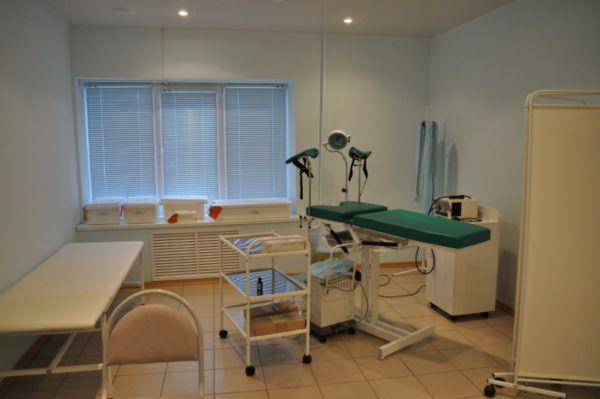
The essence of the procedure
Thanks to modern medical technologies, today it is possible to identify a serious pathology at its initial stage of development and cure the patient as quickly as possible, protecting him from all sorts of complications and negative consequences.
Proctologists have special equipment to study the intestines in detail from the inside. Thanks to such a study, a good specialist can identify the following pathologies:
Visit to the proctologist
- intestinal and duodenal ulcers
- intestinal obstruction
- haemorrhoids
- malignant neoplasms
- polyps
- colon inflammation
- mucosal damage
- anal fissures
The purpose of the examination is to detect any abnormalities, pathological processes, and prescribe proper treatment. If intestinal diseases are not identified in a timely manner, they quickly progress to a severe or chronic stage and lead to various complications.
To make your first examination with a doctor as effective as possible, it is important to prepare for the conversation. The patient should think through the answers to the questions asked by the doctor. List of most frequently asked questions:
- How often and regularly does a person go to the toilet?
- Is there pain, itching or burning during bowel movements?
- Are there any mucus, pus or blood clots in the stool?
- What is included in the weekly meal plan?
- What complaints do you have about your general condition? Are there headaches, weakness or other ailments?
Having prepared the answers in advance, the patient will be able to describe his problem in detail, help the doctor to determine the cause of the pain as quickly as possible, and prescribe therapy.
How is the reception going?
During the initial appointment, the doctor collects a complete medical history of the patient, data on diet, and lifestyle. This information may be useful when drawing up a treatment regimen, since some medications used to treat diseases of the rectum are incompatible with alcoholic beverages and require smoking restrictions. After a conversation with the patient, the doctor conducts a visual examination and palpation of the pararectal area and rectal space.
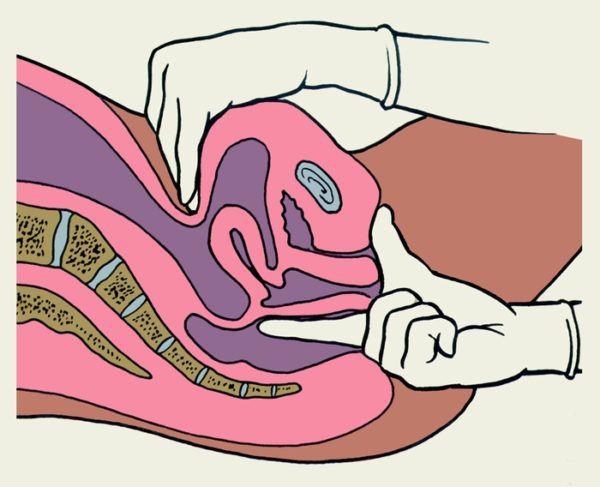
Bimanual digital rectal examination
To do this, you need to undress and take a position convenient for the procedure. The examination itself takes no more than 5-7 minutes and usually does not cause pain if performed by an experienced specialist. Based on the results of a rectal examination, the doctor will draw conclusions about the condition of the mucous membranes of the anus, the presence of tumors, polyps and cysts, signs of ulcerative and erosive defects, and the possible formation of fistula tracts. If an examination is prescribed for a patient to diagnose hemorrhoids, the doctor will be able to assess the presence of inflamed hemorrhoids, their size, number and degree of reduction. If this cannot be done manually, the patient may require surgical treatment.
Examination position
The classic position for rectal palpation is the knee-elbow position. A special cloth with a hole is placed over the patient’s buttocks, through which the doctor gains access to the area being examined. Some clinics use disposable cotton panties for this purpose.
DNA diagnostics
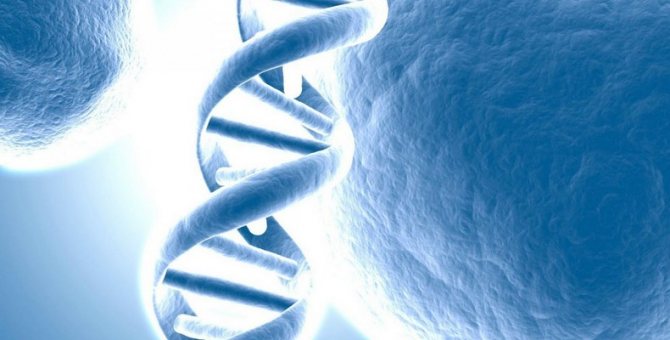
A modern molecular diagnostic method that makes it possible to determine hereditary predisposition to colon cancer. Genetics is an amazing and not fully understood science. Therefore, it is impossible to determine the exact chain of transmission of tumor cells. But, thanks to DNA, it is possible to determine a predisposition to a malignant neoplasm and prevent it in time.
All these examination methods are prescribed by a proctologist according to indications. Therefore, if you experience the slightest discomfort in the anus, abdominal pain, blood from the anus, or other symptoms, you should immediately consult a specialist. The most terrible diseases, such as cancer, occur with minimal symptoms.
Do I need to prepare for an examination?
If the patient is being examined for the first time, no special preparation is required, but certain recommendations must be followed. The day before visiting the doctor, you must avoid fried and spicy foods, pickled and canned vegetables, sweets, and alcohol. Foods containing large amounts of purines, as well as dishes that cause rotting and fermentation processes, should also be excluded from the diet. They contribute to increased formation and flatulence: these conditions can not only cause incorrect diagnosis, but also flatulence (involuntary release of gases) during palpation.
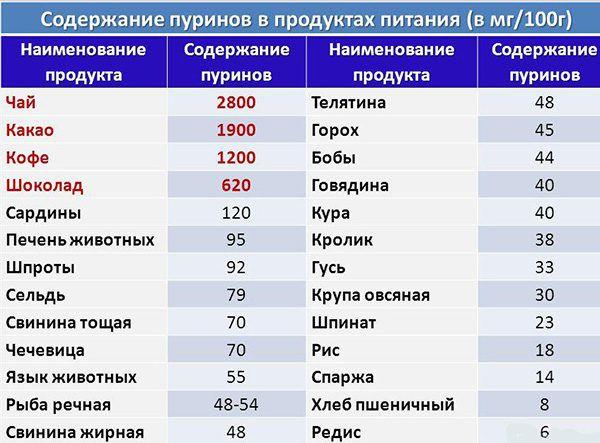
Foods containing purines
It is precisely such situations that most often cause patients to refuse to visit the proctologist again, so the day before the appointment you should avoid eating the following products:
- nuts and peanuts;
- legumes (peas, lentils, chickpeas);
- carbonated drinks and drinks containing hops, malt and yeast (kvass, beer);
- all types of cabbage;
- raw vegetables and fruits (they are allowed to be consumed boiled or baked);
- sugar;
- kefir;
- fresh bread and pastries.
Advice! In the evening before the examination, you can take a medicine from the group of carminatives based on simethicone, for example, Espumisan or Sub-Simplex. Simethicone destroys gas bubbles and prevents the formation of new gas compounds, facilitating palpation of the rectum and the psychological state of the patient during the procedure.
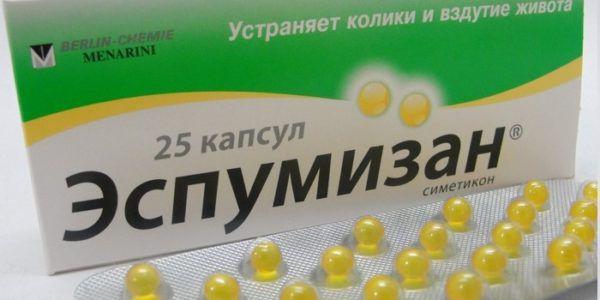
Preparation for sigmoidoscopy with Microlax: how the study works
At a doctor's appointment You can make an appointment with a proctologist at the reception desk or take a referral from a therapist.
At an appointment with a proctologist, women, men and children (if necessary) are examined. A proctologist is recommended by a therapist to examine children in rare cases, since children do not often suffer from rectal diseases. This is mainly due to poor nutrition (hemorrhoidal inflammation, constipation, diarrhea, dysbacteriosis) or anatomical features of the body. How does a woman’s proctologist appointment go? The science of proctology involves the treatment of hemorrhoids and other intestinal diseases.
When examining a female patient, the specialist prescribes the following diagnostic measures, which include:
- collecting anamnesis for concomitant pathologies;
- visual examination of the anorectal and rectal area;
- finger palpation of the organ.
For a more informative picture of the intestinal condition, additional studies may be required. How is an instrumental examination by a proctologist performed in women?
Carrying out the procedure
- anoscopy - testing the anorectal passage using an anoscope to examine the lower intestine;
- sigmoidoscopy - examination of the patient using a sigmoidoscope to detect even minor neoplasms of various nature;
- ultrasound diagnostics - examination of the peritoneal organs through the abdominal wall;
- colonoscopy – visualization of the entire intestine and its parts using a colonoscope (the most informative method for identifying all intestinal pathologies).
How an appointment with a proctologist goes, you can consult with the specialist himself at the first appointment or with a therapist who has written a referral to a highly specialized specialist. During an examination by a proctologist, women can find out the condition of the anorectal area, the functioning of the sphincter, recognize the presence of hemorrhoidal cones, benign and malignant neoplasms, assess the stage of pathology, the size of tumors, and receive a prescription plan for effective therapy.
The simplest procedure is a digital rectal examination, which is usually performed at the first visit to the doctor. For the convenience of the research procedure, women are recommended to purchase special panties with a hole in the anorectal area. This way the patient will not have a psychological disorder and embarrassment in front of the doctor. During examination there is no pain or discomfort. To visit a specialist, a woman must undergo a preparatory colon cleanse.
Home » Rectomanoscopy » Rectomanoscopy: features of preparation for the study
April 15, 2020 Rectomanoscopy
Sigmoidoscopy is an endoscopic type of examination through which the rectum and distal sigmoid colon are examined and studied. The procedure is carried out using a special instrument called a sigmoidoscope.
It is a device in the form of a tube, the length of which ranges from 25 to 35 cm. This tube does not exceed 20 mm in diameter. The sigmoidoscope is equipped with a lighting system, lenses and a device for pumping air.
In order for the rectal examination to be successful and not cause complications, the patient should be properly prepared.
Initially, it should be noted that in order to obtain a high-quality image during an examination of the rectum, the patient needs to free this organ.
To prevent waste from accumulating in the rectum, you should switch to a waste-free diet 3-5 days before the test. The basis of such a diet should be products that are not enriched with dietary fiber.
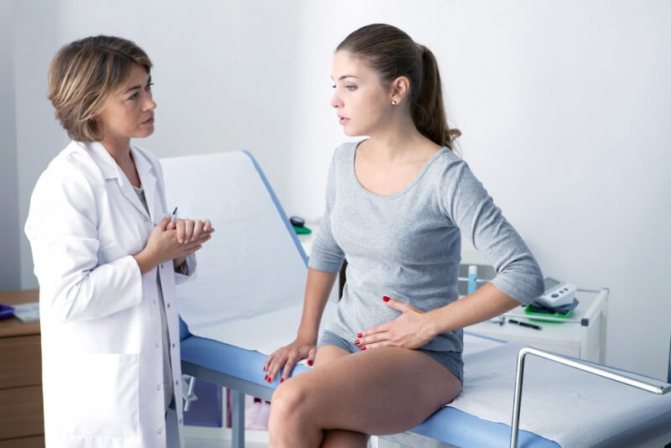
If you eat such foods, this will lead to the production of feces, which will interfere with the study.
The following types of foods should be excluded from the diet:
- fresh herbs and vegetables, namely beets, carrots and white cabbage;
- bakery products;
- citrus;
- fruits: apples, apricots, peaches;
- carbonated drinks and juices with pulp.
All these products are enriched with fiber, which takes a long time to digest. To prevent the accumulation of feces in the intestines, the patient is recommended to eat fish and lean meats.
It is important to know! Meat can only be consumed boiled or steamed. Eating fried or smoked meat will lead to intoxication of the body.
The patient is recommended to make adjustments to his diet one more week in advance and switch to consuming broths, soups, buckwheat and wheat porridge. It is better to avoid rice porridge, as it contributes to the accumulation of solid feces in the intestines.
If it turns out that the patient did not pay due attention to these requirements, the procedure may be canceled or rescheduled. Predominance in the diet should be given to the following types of food:
- dairy and fermented milk products;
- vegetable oils and homemade mayonnaise;
- juices without pulp;
- jelly and ice cream;
- lean soups and broths.
The preparatory stage also includes the procedure for collecting anamnesis. The doctor conducts a survey of the patient in advance regarding the presence of allergies, finds out the facts of taking medications, as well as conducting a gastrointestinal tract examination in the near future.
It is important to know! Most patients do not accept this type of rectal examination. This is primarily due to the fact that the sigmoidoscope is inserted into the rectal cavity through the anus.
Patients should not be embarrassed, since sigmoidoscopy is an absolutely normal type of examination, which the specialist has performed more than a dozen times.
During the study, it is possible that fecal matter may be released as the device moves forward. To ensure that feces in the rectum do not interfere with the advancement of the sigmoidoscope, the device is treated with special means.
In addition, on the day of the study, the patient is given an enema, which will wash the intestines as effectively as possible.
It is important to know! It is not recommended to give yourself an enema, as this can lead to injury to the intestinal cavity.
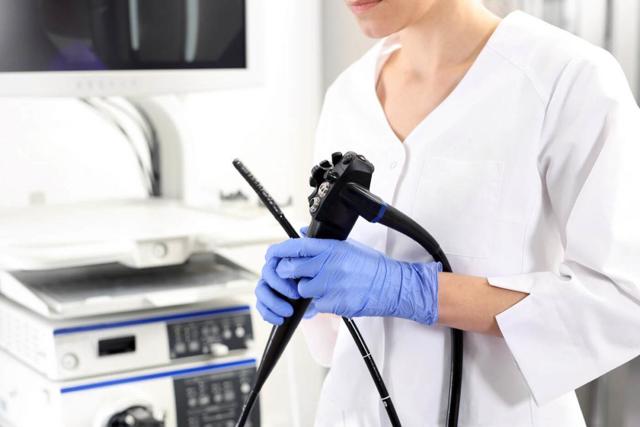
The patient should also ensure that relatives or friends can pick him up after the examination. Driving a vehicle after the study is prohibited for 12 hours, as the patient will feel discomfort. It is also prohibited to drink alcoholic beverages within 24 hours after this type of study.
It is important to know! Alcohol should also not be consumed on the eve of the examination, as it will have a detrimental effect on sigmoidoscopy and can lead to complications.
To conduct an intestinal examination, you should first cleanse it. For this purpose, enemas are given and special medications are used.
One such drug for bowel cleansing is Microlax. Preparation for sigmoidoscopy with Microlax is based on the fact that the drug has a mild laxative property.
The drug has a significant drawback, which is due to its mild laxative effect. For people who do not have problems with stool, the mild effect is the best option for cleansing the intestines without feeling discomfort. If a person has problems with stool, then the mild laxative effect will not be sufficient to cleanse the intestines.
It is worth noting that for people who have problems with stool, it is better to use a drug such as Miralax. This is an American analogue of the Russian Fortrans, which is distinguished by its high cost.
It is important to know! After using strong laxatives such as Fortrans, Lavacol and Miralax, it is imperative to drink plenty of fluids.
It is necessary to use laxatives the night before sigmoidoscopy. Microlax is administered rectally in two tubes with an interval of 20 minutes. In the morning, you need to repeat the procedure, and then go for examination.
In order to use Fortrans, you should dissolve 2 sachets in water. The bag contains instructions on how to properly dilute the product.
After dissolving the powder, you need to drink 200 ml every 20 minutes. The procedure for cleansing the intestines with Fortrans can be repeated in the morning.
At least 3 hours must pass from taking the drug to the start of the procedure, so it is necessary to calculate the time.
When are enemas given? Colon cleansing with an enema is carried out 3-4 times. Two enemas are given in the evening, for which 2 liters of water are used. In the morning, the enema is repeated as many times as necessary until clean and clear water comes out of the intestines. Colon cleansing with enemas is the best and most effective method, which has the disadvantage of discomfort.
The rectal examination procedure can be performed in two positions, one of which the patient should take after exposing the lower torso. The most popular pose is on your side, with your legs bent at the knee joints. If the patient is comfortable, he can also take a knee-elbow position.
Initially, the doctor treats the anus with Vaseline, which increases the permeability of the device. The sigmoidoscope is also treated with Vaseline, which is inserted through the anus at 5 and 10 cm.
The sigmoidoscope is inserted further and further, while the specialist periodically pumps it up. This is necessary in order to expand the walls of this organ and smooth out the folds of the mucous membrane. As the device advances, the doctor examines the inner walls of the intestine, detecting defects and pathologies.
Patients are interested in the question of whether it is painful to do sigmoidoscopy? The procedure is painless, but the patient will feel discomfort. No local anesthesia is used to reduce discomfort. The study is also carried out without the use of general anesthesia. To reduce discomfort, the patient should relax as much as possible.
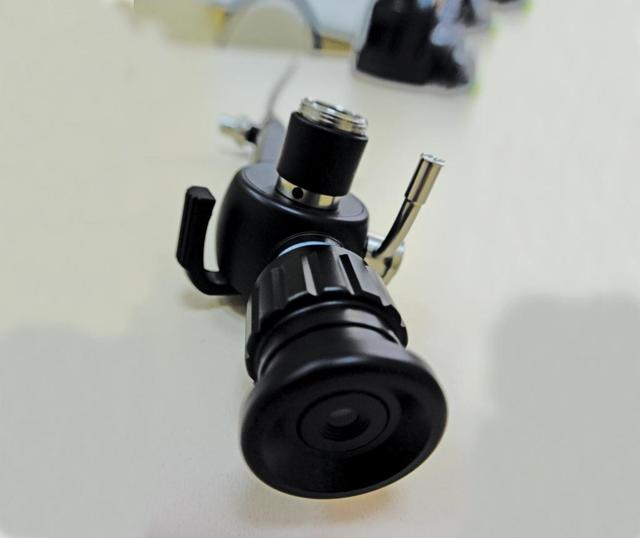
It is important to know! 12 cm from the anus there is a bend of the intestine. If the patient is not relaxed enough, minor pain symptoms will be felt when the device moves from the rectum to the sigmoid colon.
